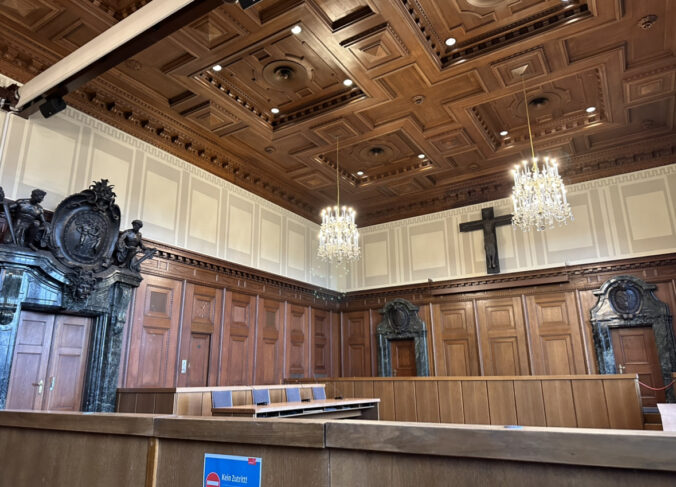Our first day began in the lobby of hotel Adina. We filled our plates with mini sausages, scrambled eggs, baby pancakes, flakey-soft croissants, and, most important, wafer cups filled with hazelnut spread freshly sourced from the spout of an automated Nutella machine. We departed the hotel and took a short bus ride to our next destination, a historical multi-use space for the people of Nuremberg. The grounds house Nuremberg State Philharmonic Orchestra’s acclaimed open air concerts and the annual carnival-games- and food-filled Nürnberger Volksfest; this was also once Hitler’s and the Nazi party’s very own arena and marching grounds.
Although the Nazi party had an expansive vision for the grounds, not much building was actually completed here under the Third Reich. The start of WWII forced the Nazis to divert their 14,000-person team of builders on the Colosseum-inspired arena and grounds to work in the factories producing ammunition and other war supplies. Yet, they still managed to get pretty far on one building, leaving a large structure of what would’ve housed 50,000 people (three times the capacity of the Colosseum). The incomplete building stands in Nuremberg today and its use is contentious. It was nearly turned into a soccer field in the years following the war, a plan only stopped for lack of funds. Then, it was even closer to becoming a shopping mall, thought to be a terrible idea by many in the community. Now, it received the green light to be used as an arts and culture center. Our group agreed that using former Nazi-party stomping grounds as anything but an educational tool is reprehensible. But our tour guide explained that many Germans feel that the grounds should be updated to include economic and cultural development to reduce the risk that the space becomes a monument to the Nazi party. The debate has been stalled due to the discovery of asbestos, which has stalled the construction of the opera house within.
After our first tour of the day concluded, we took a short lunch break at a Greek chain called Gregory’s Coffee. Our second tour commenced soon after at the Nuremberg trials courthouse museum.
At the museum, we discussed both freedom of speech and church-state separation in Germany. The first topic was inspired by Julius Streicher, one of the 21 Nazi leaders put on trial at the international war crimes tribunal in Nuremberg in 1945. Streicher was a journalist and publisher of the unimaginably horrific antisemitic newspaper, Der Stürmer, during the Third Reich. He was found guilty for his publications and abhorrent speech calling for the annihilation of Jewish people. We learned that after WWII, many words, phrases, and hand movements associated with Nazis and Hitler are outright banned in Germany, where breaking that rule results in an investigation and a fine.
Nuremberg courtroom 600 became a working domestic courtroom following the war. Some time in the 1950s, a large wooden and metal crucifix was affixed to the center-front part of the room, directly above where the judges sit. Although religious symbols are banned in public spaces in Germany, Bavaria passed a state law circumventing the federal one, which explains the presence of this religious symbol. To an American, this seemingly lax separation of church and state is further exemplified by a religious tax. Three-percent of income is collected from people who identify as official members of churches, synagogues, and even some mosques.
The tax does come with benefits, including a reserved spot at a church-run school, a particularly big plus for Lutherans with the best kindergartens and high schools in town. It also gives you access to a church’s healthcare system, elderly care facilities, and the ability to be “married or buried” by your church.
After our two tours and before dinner, a handful of tired students set out in search of a coffee shop with Wifi, hafermilch (oat milk), and eisgekühlter lattes (iced latte). This is evidently a hard ask in Germany! While we did find one that checked the boxes, it had no room for us to sit indoors. We then set off on a mission to find a sweet treat or salty snack to hold us over until dinner, stopping only briefly to get cute pics in front of our favorite bridge.
